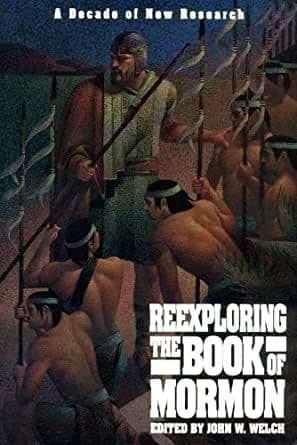Book
85 Chapters

Helaman 3:8 “They began to cover the face of the whole earth, from the sea south to the sea north.”
The F.A.R.M.S. Update for November 1986 presented recent archaeological evidence to show that ancient Mesoamerican peoples interacted extensively with cultures in South America (see preceding chapter), suggesting ways that aspects of Nephite civilization and actual people could have become dispersed widely to the south. Material is pointed out here similarly linking Mesoamerica with North America.
In Joseph Smith’s day there was a view that the western hemisphere was populated across the Bering Strait, and that civilization moved from the Northwest through North America and then to Central America. Contrary to that view, the Book of Mormon speaks of migrations going the opposite way, from the land southward to the north, in the first century before Christ (see Alma 63:4; Helaman 3:8). Today, archaeologists, linguists, and historians who have studied the matter are agreed that a long sequence of cultural transmissions and migrations moved northward from southern Mexico.
The data from the southwestern United States is impressive. For example, the Hohokam culture of Arizona shows so many similarities to the cultures of Mexico that all who have investigated the matter have concluded that much of Hohokam culture originated in Mesoamerica. Canal irrigation, a ball game using a specially prepared court and rubber ball, and “temple mounds” are among these shared elements. They date from before the time of Christ to around A.D. 1400.1 Florence Hawley, a leading scholar in this area, concludes that the attributes of the gods worshipped in these two areas were so similar that “derivation must be assumed” from the south. She and Laurens Hammack describe in detail the ritual and cosmological role of caves, solstice marking, the two-headed snake, lakes, shrines, and kickball games intended to make rain. The parallels also include the deities known in Mexico as Quetzalcoatl, Tlaloc, and Tezcatlipoca.2 The domesticated barley recently discovered among the Hohokam ruins and elsewhere offers another significant linkage with Mosiah 9:9 and Alma 11:7.3
In the Mississippi and Ohio River valleys and in the southeastern states, evidence for cultural and linguistic intrusions from Mexico is also strong. Charles Wicke observes, “Most Southeastern specialists now seem to grant that the concept of the temple mound is Mesoamerican in origin. Indeed, the evidence for this is overwhelming.”4 The pyramid concept arrived in the southern Mississippi River Valley by around the time of Christ. Even earlier, burial mounds had appeared, also likely originating in Mesoamerica, which agrees with the fact that the corn grown by the Hopewell people in the centuries just before Christ was a Guatemalan type.5 Massive mounds and evidence of solar orientation along with artifacts that recall the Olmecs have also been found at Poverty Point, Louisiana, dating to Jaredite times.6
Apparently, from these and many other studies, peoples and cultural elements have spread by migration and trade from Mexico into North America periodically since well before the time of Christ. Although we cannot identify these movements with the Book of Mormon account specifically, we can see that the kind of migrations northward mentioned in the Book of Mormon are substantiated in general. Through avenues such as these, we again can also see how some of the Jaredites, Nephites, Lamanites, or Mulekites, or their descendants, or aspects of their culture, could easily have spread out, here a little and there a little, over the North American continent.
Based on research by John L. Sorenson, February 1987.
1. See Martha Molitor, “The Hohokam-Toltec Connection,” University of Northern Colorado Museum of Anthropology Occasional Publications 10 (1981): 32-155; Julian D. Hayden, “Of Hohokam Origins and Other Matters,” American Antiquity 35 (1970): 87-93.
2. Florence Hawley, Ellis and Laurens Hammack, “The Inner Sanctum of Feather Cave, A Mogollon Sun and Earth Shrine Linking Mexico and the Southwest,” American Antiquity 33 (1968): 25-44; Carroll L. Riley and Basil C. Hedrick, eds., Across the Chichimec Sea(Carbondale: Southern Illinois University Press, 1978).
3. See pp. 130-32 in this book.
4. Charles R. Wicke, “Pyramids and Temple Mounds: Mesoamerican Ceremonial Architecture in Eastern North America,” American Antiquity 30 (1965): 410; James B. Griffin, “Mesoamerica and the Eastern United States in Prehistoric Times,” in Gordon R. Willey and Gordon F. Elkholm, eds., Archaeological Frontiers and External Connections, volume 4 of Handbook of Middle American Indians (Austin, Texas: University of Texas Press, 1966), 111-31.
5. See Thomas M. Lewis and Madeline Kneberg, Tribes that Slumber: Indians of the Tennessee Region (Knoxville: University of Tennessee Press, 1958), 57.
6. See Clarence H. Webb, “The Extent and Content of Poverty Point Culture,” American Antiquity 33 (1968): 297-321.
Book
85 Chapters
Items in the BMC Archive are made publicly available for non-commercial, private use. Inclusion within the BMC Archive does not imply endorsement. Items do not represent the official views of The Church of Jesus Christ of Latter-day Saints or of Book of Mormon Central.